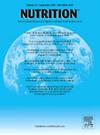握力和血小板白蛋白比作为癌症恶病质患者的联合预后指标
IF 3.2
3区 医学
Q2 NUTRITION & DIETETICS
引用次数: 0
摘要
背景:握力(HGS)和血小板白蛋白比(PAR)是癌症恶病质的预后指标。本研究使用单一指数(HPA)评估HGS和PAR在预测年龄≥18岁的恶病质癌症患者生存结局中的联合疗效。方法2013年7月至2022年4月开展的多中心常见癌症营养状况及其临床结果研究纳入了5189名参与者。采用最优分层法确定HGS和PAR的阈值,从而形成HPA指数。预后准确性评估采用时间依赖的受试者工作特征分析、Kaplan-Meier生存曲线和Cox比例风险模型。结果该队列包括3127名男性和2062名女性,中位随访时间为36个月,平均年龄为58岁。低HGS阈值为19 kg(女性)和31.9 kg(男性),高PAR阈值为9.07 × 10⁹(女性)和6.52 × 10⁹(男性)。低HGS和高PAR水平都与死亡风险增加有关。HPA指数显示较好的预后准确性(C-index = 0.611;95%置信区间:0.58-0.61;P & lt;0.001),与单独的HGS或PAR相比。Kaplan-Meier分析显示,低HGS和高par患者的生存期明显降低。结论HPA指数是临床诊断癌症恶病质的重要预后工具,可提高患者的生存预测能力,指导患者的治疗。本文章由计算机程序翻译,如有差异,请以英文原文为准。
Handgrip strength and platelet-to-albumin ratio as joint prognostic indicator for patients with cancer cachexia
Background
Handgrip strength (HGS) and platelet-to-albumin ratio (PAR) are established prognostic markers of cancer cachexia. This study evaluates the combined efficacy of HGS and PAR using a single index (HPA) for predicting survival outcomes in cancer patients with cachexia aged ≥18 years.
Methods
The multicenter Nutrition Status and Its Clinical Outcomes in Common Cancers study, conducted from July 2013 to April 2022, enrolled 5189 participants. Thresholds for HGS and PAR were determined using optimal stratification, leading to the development of HPA index. Prognostic accuracy was assessed using time-dependent receiver operating characteristic analysis, Kaplan–Meier survival curves, and Cox proportional hazards models.
Results
The cohort consisted of 3127 men and 2062 women, with a median follow-up of 36 months, and mean age of 58 years. Low HGS thresholds were 19 kg (female) and 31.9 kg (male), and high PAR cut-offs were 9.07 × 10⁹ (female) and 6.52 × 10⁹ (male). Both low HGS and high PAR levels were linked to increased mortality risk. The HPA index showed superior prognostic accuracy (C-index = 0.611; 95% confidence interval: 0.58–0.61; P < 0.001) compared with HGS or PAR alone. Kaplan–Meier analysis indicated significantly reduced survival in patients with low HGS and high PAR.
Conclusions
The HPA index is a clinically significant prognostic tool for cancer cachexia, enhancing survival prediction and guiding patient management.
求助全文
通过发布文献求助,成功后即可免费获取论文全文。
去求助
来源期刊

Nutrition
医学-营养学
CiteScore
7.80
自引率
2.30%
发文量
300
审稿时长
60 days
期刊介绍:
Nutrition has an open access mirror journal Nutrition: X, sharing the same aims and scope, editorial team, submission system and rigorous peer review.
Founded by Michael M. Meguid in the early 1980''s, Nutrition presents advances in nutrition research and science, informs its readers on new and advancing technologies and data in clinical nutrition practice, encourages the application of outcomes research and meta-analyses to problems in patient-related nutrition; and seeks to help clarify and set the research, policy and practice agenda for nutrition science to enhance human well-being in the years ahead.
 求助内容:
求助内容: 应助结果提醒方式:
应助结果提醒方式:


